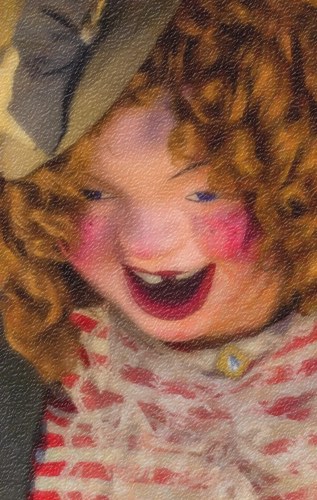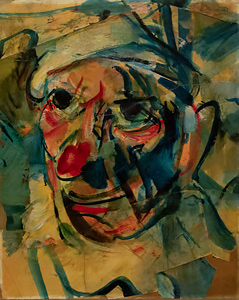Photo Corners headlinesarchivemikepasini.com
![]()
A S C R A P B O O K O F S O L U T I O N S F O R T H E P H O T O G R A P H E R
![]()
Enhancing the enjoyment of taking pictures with news that matters, features that entertain and images that delight. Published frequently.
Laffing Sal




31 July 2018
We made the acquaintance of Laffing Sal in our youth. It must have been a birthday party. The kids were transported to Playland at the Beach in a station wagon or two to spend a few hours in The Fun House.

Sal stood at the entrance to The Fun House behind some glass, high enough so we had to look up at her while we waited to get in. And she would rock back and forth, laughing interminably.
She resembled a clown without quite being one. You might have though she was a leprechaun if leprechauns were six feet tall and female. You could be forgiven if you thought she was drunk.
You could be frightened of her. Or you could join in and find it hard to stop laughing yourself.
There was no clue what she was laughing at. Everything was funny to Sal.
And yet, like Pagliacci, there was something tragic about her. You certainly didn't want her to jump in the station wagon for the trip home.
We ran into Sal again at the Musée Méchanique at Fisherman's Wharf and just had to take her picture. It was hard to avoid reflections on her glass case but we finally found an angle.
Editing the image, we were unhappy with that angle and the background and the case itself. They all seemed to distract from the tragic lady who found herself amused to pieces.

Georges Rouault. The Clown (1907).
So we cropped tight and found our Sal.
We had one more idea. Above our night stand is a print we made of Georges Rouault's 1907 painting The Clown. Below, we are reprising the story we published in our ebook Beginner's Flash, a perk for our subscribers, about making that print.
What we especially like about the painting we photographed when it visited the de Young here in 2012 is that the support is not a single piece of paper but shreds of torn paper. Look closely and you'll detect the torn edges of the paper.
That spoke to us of the tragic nature of the clown. Of Sal. Of Pagliacci. Of Emmett Kelly's Weary Willie.
We thought we'd do something like that with Sal. So we ran our JPEG through Alien Skin's Snap Art, turning it into a watercolor and adding a hot press paper texture to it.
We didn't tear the edges. We might. But it stands on its own as a faux watercolor and, if you know the story of Rouault's clown, it echoes that.
And a Sal that echoes is just a bit over the top, considering that laugh.
Shooting Rouault
We visited the de Young Museum the other day to have a look at an exhibit of paintings, sculpture and drawings from the William S. Paley Collection. No intention whatsoever of shooting anything. You can't shoot special exhibitions anyway. Right?
Wrong. At least for this one. As long as you didn't use flash, you could shoot everything in the show.
We're not sure why it's OK to use the focus assist lamp, but that's still OK. We turned ours off anyway. It just seemed to rude to other art lovers.
We realized you could photograph the Paley collection when we noticed a fellow with a digicam on about the same route as us shooting every painting. Then we saw the "No Flash Photography" sign, implying of course you could indeed shoot the show.
Pretty cool when you think about it. You could take home as many Paleys as you want, print them on your photo printer, buy frames for them and live like a rich guy in Manhattan the rest of your life, surrounded by fine art.
And many of the paintings were small, so you could enjoy them at full size even with a letter-page size photo printer.
Still, we had no desire to get the camera out of the bag and fiddle around.
For one thing, the Paley exhibit was particularly poorly lit. Nearly everyone had to put their nose on the placards to read them. Each person then apologized to everyone around them for not being able to see. If eyeballs had trouble in that light, we rationalized, a camera would have an even harder time.
Which was a position we maintained until we got to the last room and saw Georges Rouault's "The Clown." You can see a reproduction in the de Young blog.
We are a sucker for images of clowns even since the first trade paperback cover illustration of one on Henrich Boll's novel "The Clown." Pagliacci's story always brings a tear to our eyes and Boll's recasting it in postwar Germany is a wonderful read.
What struck us about Rouault's clown, though, was that it wasn't painted on a single piece of canvas or paper. Instead, it was painted on scraps of paper pasted together on a board. You could see the seams clearly. Even in that light.
The placard explained that he'd been inspired by an old clown he saw sitting at a gypsy wagon repairing his brightly colored costume. So Rouault repaired his canvas for the clown. The poetry was what got us. We whipped out the camera.
The first shot we took was of a WhiBal, Michael Tapes' digital gray card. That would help us correct the white balance later. We shot the WhiBal in the same spotlight that fell on the painting but we focused on the placard.
Then we framed up the painting as squarely as we could and took a shot in plain old Program mode. You know, to avoid any suspicion that we know what we're doing. "Look, officer," we could say, "we're shooting in Auto Program mode. We're not making any money on this!"
When we got the shot back to the bunker, we pulled it up for analysis.
The vital stats were revealing. The zoom lens was wide open at its focal length but only f3.9. ISO was cranked up automatically to 1600, a scary thing. And shutter speed was a barely sensible 1/20 second -- except the Olympus E-PL1 we used features body-based image stabilization. So 1/20 second was safe.
And in fact the image was sharp.
We applied the WhiBal white balance correction to the image generated by the Raw file and a slight crop later, it was ready to print.
It's tricky moving the image of an artwork from your screen to paper -- and not for the usual reasons of printing any photo. You have to pick a finish that doesn't get in the way of the original support if it's visible. A matte paper? A semi-gloss? Canvas? We went with semi-gloss.
We didn't worry too much about the noise at ISO 1600 either. It wasn't visible on the print. Of course by then Adobe Camera Raw had minimized it. And the detail that most mattered to us (the patched paper) was as obvious in the print as the original.
Except, you know, you could see it in broad daylight on our print.